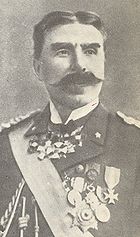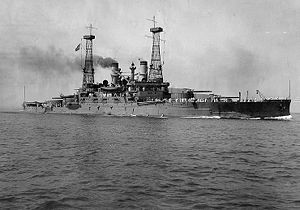
Vittorio Cuniberti
Encyclopedia

Turin
Turin is a city and major business and cultural centre in northern Italy, capital of the Piedmont region, located mainly on the left bank of the Po River and surrounded by the Alpine arch. The population of the city proper is 909,193 while the population of the urban area is estimated by Eurostat...
, Piedmont
Piedmont
Piedmont is one of the 20 regions of Italy. It has an area of 25,402 square kilometres and a population of about 4.4 million. The capital of Piedmont is Turin. The main local language is Piedmontese. Occitan is also spoken by a minority in the Occitan Valleys situated in the Provinces of...
– 1913) was an Italian
Italy
Italy , officially the Italian Republic languages]] under the European Charter for Regional or Minority Languages. In each of these, Italy's official name is as follows:;;;;;;;;), is a unitary parliamentary republic in South-Central Europe. To the north it borders France, Switzerland, Austria and...
military officer who envisioned the concept of the all big gun battleship, best exemplified by HMS Dreadnought
HMS Dreadnought (1906)
HMS Dreadnought was a battleship of the British Royal Navy that revolutionised naval power. Her entry into service in 1906 represented such a marked advance in naval technology that her name came to be associated with an entire generation of battleships, the "dreadnoughts", as well as the class of...
.
Cuniberti's article
Born in TurinTurin
Turin is a city and major business and cultural centre in northern Italy, capital of the Piedmont region, located mainly on the left bank of the Po River and surrounded by the Alpine arch. The population of the city proper is 909,193 while the population of the urban area is estimated by Eurostat...
, Cuniberti is best known for an article he wrote in Jane's Fighting Ships
Jane's Fighting Ships
Jane's Fighting Ships is an annual reference book of information on all the world's warships arranged by nation, including information on ship's names, dimensions, armaments, silhouettes and photographs, etc...
, advocating a concept known as the "all-big-gun" fighting ship.
Up till then naval powers had developed ships with a mixture of guns with different calibres. There was constant experimentation with calibres and layout. Ships, at the time, were driven by lumbering great reciprocating engine
Reciprocating engine
A reciprocating engine, also often known as a piston engine, is a heat engine that uses one or more reciprocating pistons to convert pressure into a rotating motion. This article describes the common features of all types...
s.
The ship Cuniberti envisaged in his article was a "colossus" of the seas. His main idea was that this ship would carry only one calibre of gun, the biggest.
Powerfully armoured, this colossus would be impervious to all but the 12 inches (305 mm) guns of the enemy. Cuniberti saw the enemy's small calibre gun as having no effect on his heavily armoured colossus. His ship would carry a single calibre of gun, the largest; at the time 12 inch. Cuniberti's "ideal ship" had 12 of these large calibre guns and she would show a significant advantage over the (usual) 4 of the enemy ship.
His ship would be fast, so that this colossus would choose her point of attack.
Cuniberti saw this ship able to discharge such a heavy broadside
Broadside
A broadside is the side of a ship; the battery of cannon on one side of a warship; or their simultaneous fire in naval warfare.-Age of Sail:...
, all of one heavy calibre, that she would engulf first one enemy ship, moving on to the next, and the next, disdainfully destroying an entire enemy fleet. He conjectured the effect of a squadron of, say six, "colossi" would give this fleet such an overwhelming power as to deter all possible opponents.
Naturally there was a cost and part of Cuniberti's contention was that this colossus was available only to a "navy at the same time most potent and very rich".
Cuniberti approached the Italian government to build a ship based on his ideas. The Italian government declined, but gave Cuniberti permission to write an article for Jane's Fighting Ships.
Cuniberti's article was published before the Battle of Tsushima
Battle of Tsushima
The Battle of Tsushima , commonly known as the “Sea of Japan Naval Battle” in Japan and the “Battle of Tsushima Strait”, was the major naval battle fought between Russia and Japan during the Russo-Japanese War...
, which vindicated his ideas. There, the real damage was inflicted by the large calibre guns of the Japanese fleet
Imperial Japanese Navy
The Imperial Japanese Navy was the navy of the Empire of Japan from 1869 until 1947, when it was dissolved following Japan's constitutional renunciation of the use of force as a means of settling international disputes...
.
He died in Rome.
Dreadnoughts
.jpg)
Battle of Trafalgar
The Battle of Trafalgar was a sea battle fought between the British Royal Navy and the combined fleets of the French Navy and Spanish Navy, during the War of the Third Coalition of the Napoleonic Wars ....
there was a serious challenge to the Royal Navy
Royal Navy
The Royal Navy is the naval warfare service branch of the British Armed Forces. Founded in the 16th century, it is the oldest service branch and is known as the Senior Service...
. A short distance across the North Sea
North Sea
In the southwest, beyond the Straits of Dover, the North Sea becomes the English Channel connecting to the Atlantic Ocean. In the east, it connects to the Baltic Sea via the Skagerrak and Kattegat, narrow straits that separate Denmark from Norway and Sweden respectively...
the German Navy
Kaiserliche Marine
The Imperial German Navy was the German Navy created at the time of the formation of the German Empire. It existed between 1871 and 1919, growing out of the small Prussian Navy and Norddeutsche Bundesmarine, which primarily had the mission of coastal defense. Kaiser Wilhelm II greatly expanded...
was building a powerful fleet. Behind that fleet lay the overwhelming power of the German Army
German Army (German Empire)
The German Army was the name given the combined land forces of the German Empire, also known as the National Army , Imperial Army or Imperial German Army. The term "Deutsches Heer" is also used for the modern German Army, the land component of the German Bundeswehr...
. Behind Britain's sea shield lay her numerically small (but fully professional and highly effective) army
British Army
The British Army is the land warfare branch of Her Majesty's Armed Forces in the United Kingdom. It came into being with the unification of the Kingdom of England and Scotland into the Kingdom of Great Britain in 1707. The new British Army incorporated Regiments that had already existed in England...
, the 'Old Contemptibles.
The challenge to Britain was serious. Admiral Sir John Fisher, Royal Navy, was the driving force behind the revolutionary HMS Dreadnought
HMS Dreadnought (1906)
HMS Dreadnought was a battleship of the British Royal Navy that revolutionised naval power. Her entry into service in 1906 represented such a marked advance in naval technology that her name came to be associated with an entire generation of battleships, the "dreadnoughts", as well as the class of...
. The ship was completed in a year and day and was launched in 1906. Dreadnought's speed was ensured by using the revolutionary Parsons'
Charles Algernon Parsons
Sir Charles Algernon Parsons OM KCB FRS was an Anglo-Irish engineer, best known for his invention of the steam turbine. He worked as an engineer on dynamo and turbine design, and power generation, with great influence on the naval and electrical engineering fields...
turbines
Steam turbine
A steam turbine is a mechanical device that extracts thermal energy from pressurized steam, and converts it into rotary motion. Its modern manifestation was invented by Sir Charles Parsons in 1884....
.
Immediately this ship defined the era. It rendered all previous battleships obsolete, because ship to ship Dreadnought would sink them. Thereafter all battleships following its design would be referred to, generically, as "dreadnoughts".
Convergence


USS South Carolina (BB-26)
USS South Carolina , the lead ship of her class of dreadnought battleships, was the fourth ship of the United States Navy to be named in honor of the eighth state, and was the first American dreadnought or all-big gun battleship....
, the Japanese (incorporating some British technology) were building the Satsuma
Japanese battleship Satsuma
|-External links:**...
.
Cuniberti, however, was the first man to publish the idea.
Cuniberti's influence on Russian dreadnoughts
After the launch of the Royal NavyRoyal Navy
The Royal Navy is the naval warfare service branch of the British Armed Forces. Founded in the 16th century, it is the oldest service branch and is known as the Senior Service...
's Dreadnought, Russia
Russia
Russia or , officially known as both Russia and the Russian Federation , is a country in northern Eurasia. It is a federal semi-presidential republic, comprising 83 federal subjects...
, along with all other major naval nations, saw its fleet of battleships rendered obsolete overnight. In Russia's case this was exacerbated by the losses suffered in the Russo-Japanese war
Russo-Japanese War
The Russo-Japanese War was "the first great war of the 20th century." It grew out of rival imperial ambitions of the Russian Empire and Japanese Empire over Manchuria and Korea...
. The Imperial Russian Navy
Imperial Russian Navy
The Imperial Russian Navy refers to the Tsarist fleets prior to the February Revolution.-First Romanovs:Under Tsar Mikhail Feodorovich, construction of the first three-masted ship, actually built within Russia, was completed in 1636. It was built in Balakhna by Danish shipbuilders from Holstein...
was short of battleships.
The Gangut class battleship
Gangut class battleship
The Gangut-class battleships were the first dreadnoughts begun for the Imperial Russian Navy before World War I. They had a convoluted design history involving several British companies, evolving requirements, an international design competition, and foreign protests...
s were ordered. After a convoluted bidding process they were eventually built in Russia, with "technical assistance and supervision" by John Brown and Co.
John Brown & Company
John Brown and Company of Clydebank was a pre-eminent Scottish marine engineering and shipbuilding firm, responsible for building many notable and world-famous ships, such as the , the , the , the , the , and the...
, "but the influence of Cuniberti was evident".

